The Intel Skylake Mobile and Desktop Launch, with Architecture Analysis
by Ian Cutress on September 1, 2015 11:05 PM ESTThe Claims
As with any launch, there are numbers abound from Intel to explain how the performance and experience of Skylake is better than previous designs as well as the competition.
As with Haswell and Broadwell, Intel is implementing a mobile first design with Skylake. As with any processor development structure the primal idea is to focus on one power point as being the most efficient and extend that efficiency window as far in either direction as possible. During IDF, Intel stated that having an efficiency window from 4.5W to 91W is a significant challenge, to which we agree, as well as improving both performance and power consumption over Broadwell at each stage.
Starting at 4.5W, we spoke extensively with parts of Intel at IDF due to our Broadwell-Y coverage. From their perspective Broadwell-Y designs were almost too wide ranging, especially for what is Intel’s premium low-power high performance product, and for the vendors placing it in an ill-defined chassis far away from Intel’s recommended designs gave concern to the final performance and user experience. As a result, Intel’s guidelines to OEMs this generation are tightened so that the designers looking for the cheaper Core M plastic implementations can tune their design to get the best out of it. Intel has been working with a few of these (both entry Core M and premium models) to enact the user experience model.
Overall however, Intel is claiming 40% better graphics performance for Core M with the new Generation 9 (Gen9) implementation, along with battery saving and compatibility with new features such as RealSense. Because Core-M will find its way into products from tablets to 2-in-1s and clamshells, we’ve been told that the Skylake design should hit a home-run against the best-selling tablets in the market, along with an appropriate Windows 10 experience. When we get units in to review, we will see what the score is from our perspective on that one.
For the Skylake-Y to Skylake-U transition (and in part, Skylake-H), Intel is claiming a 60% gain in efficiency over Haswell-U. This means either 60% less active power during media consumption or 60% more CPU performance at the same power (measured by synthetics, specifically SPECint_base_rate2006). The power consumption metrics comes from updates relating to the Gen9 graphics, such as multi-plane overlay and fixed-function decoders, as well as additional power/frequency gating between the unslice and slices. We will cover this later in the review. The GPU itself, due to the new functionality, is claiming 40% better graphics performance for Core M during 3DMark synthetic tests.
While not being launched today, Intel’s march on integrated graphics is also going to continue. With the previous eDRAM parts, Intel took the crown for absolute IGP performance from AMD, albeit being in a completely different price band. With Skylake, the introduction of a 4+4e model means that Intel’s modular graphics design will now extend from GT1 to GT4, where GT4e has 72 execution units with 128MB of eDRAM in tow. This leads to the claim that GT4e is set to match/beat a significant proportion of the graphics market today.
Back in our Skylake-K review, we were perhaps unimpressed with the generational gain in clock-for-clock performance, although improved multi-threading and frequency ranges helped push the out-of-the-box experience. The other side of that performance is the power draw, and because Skylake is another mobile-first processor, the power aspect becomes important down in mobile devices. We will go through some of these developments to improve power consumption in this article.


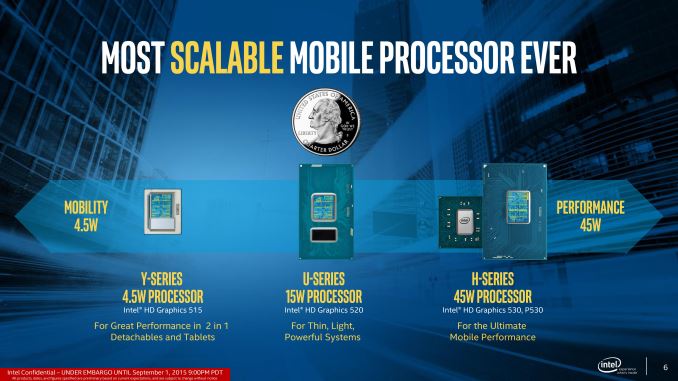
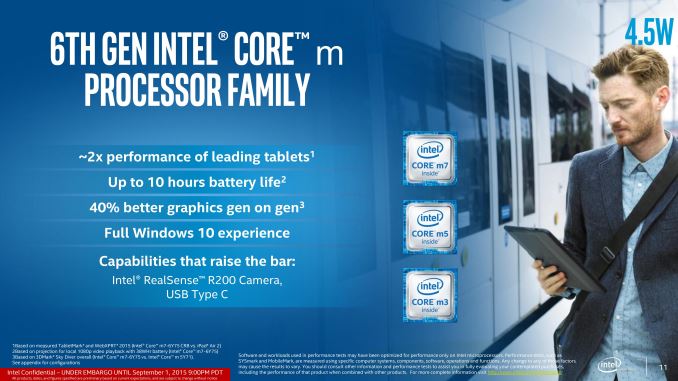
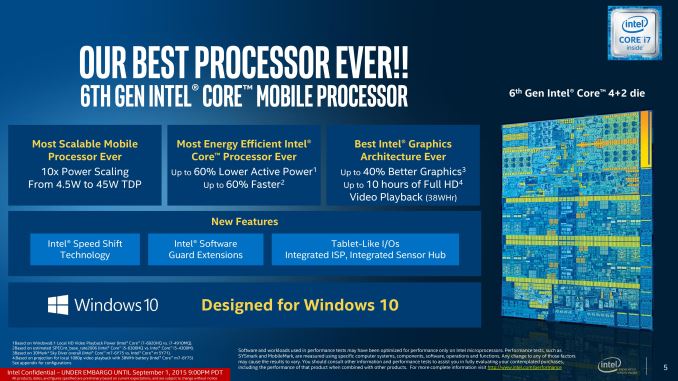
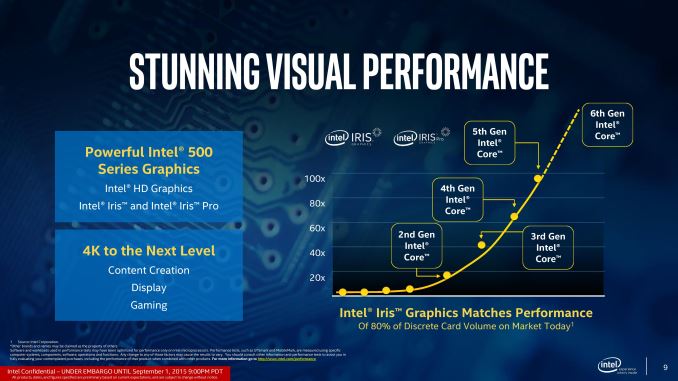
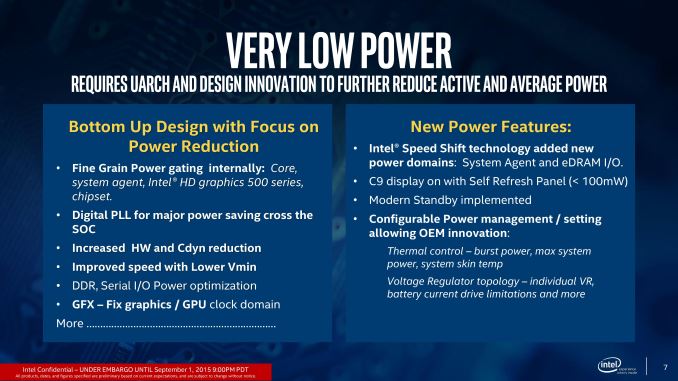








173 Comments
View All Comments
MrSpadge - Wednesday, September 2, 2015 - link
The primary reason Skylake is only qualified for DDR4-2133 is that there is no faster JEDEC standard yet. That's also the reason AT tested at that, I think. However, I agree: restraining an "enthusiast OC CPU" like that seems silly, especially given the very small price premium of significantly faster DDR4. I hope some memory scaling analysis is included in future Skylake articles.techguymaxc - Wednesday, September 2, 2015 - link
Good point, you are correct in that this is the root cause, my analysis suggests the reason is one step further down (or up, depending on your view) the ladder.wintermute000 - Wednesday, September 2, 2015 - link
can the non K chips operate above 2133 or are they locked to 2133 (like non K haswell @ 1600)techguymaxc - Thursday, September 3, 2015 - link
Someone correct me if I'm wrong here, but I believe that is a motherboard feature. As long as you're using a Z series chipset-based motherboard, you *should* be able to run faster memory.MrSpadge - Thursday, September 3, 2015 - link
Sounds plausible.. but noone is talking about that. Damn it! Not even a single review of the regular 6700, and it has been on the shelves in better quantities than the 6700K for 2-3 days (Germany).Impulses - Friday, September 4, 2015 - link
Not available or even listed anywhere yet stateside... :/NikosD - Monday, September 7, 2015 - link
Actually, non K Haswell like Core i7 4790 using a Z chipest can most of the times reach DDR3-2133MHz with no problems.There is only multiplier lock from Intel, not memory lock to 1600MHz.
Xenonite - Thursday, September 3, 2015 - link
Actually, enthusiasts only focus on achieving the lowest possible system power.It seems that most people wouldn't mind further gimping Skylake's performance by underclocking DDR4-2133 to the lowest allowed setting, in the name of needless desktop power savings.
nils_ - Thursday, September 3, 2015 - link
You haven't seen German energy prices ;)Xenonite - Thursday, September 3, 2015 - link
Yea I'm sure there are a lot of readons why we are in this situation (buying a $100 CPU and then having to spend more than that on electricity costs seems a little silly if you are on such a tight budget to begin with); but I still find it increadibly sad that, even if you are willing to spend $1000 on the best CPU performance that money can buy (Xeons aren't overclockable, so a heavily overclocked consumer CPU is normally able to beat almost all single-socket workstations, even in heavily multi-threaded workloads), you are still constrained by some arbitrary power limit.Being willing to spend your hard earned cash on $1000~$2000 of power bills per year still doesn't change the fact that you cannot, and will NEVER be able to, build a system that can make proper use of that amount of power for maximum high-framerate gaming performance.
(Ps. I currently live in South Africa, where our electricity costs are pretty much on par with, and sometimes (if your skin color, like mine, isn't black) even greatly exceeds those of Germany. Heck, once you pass